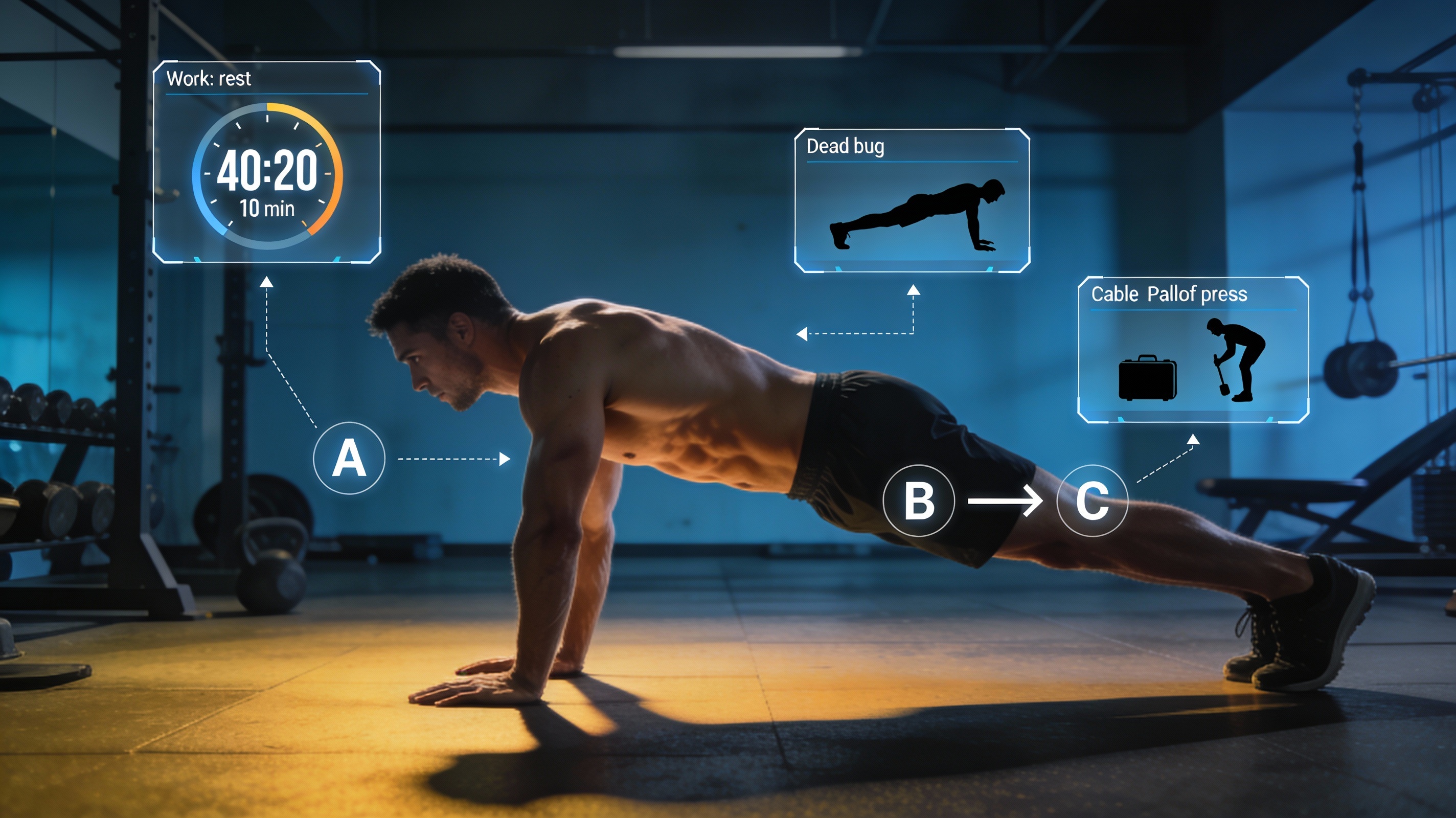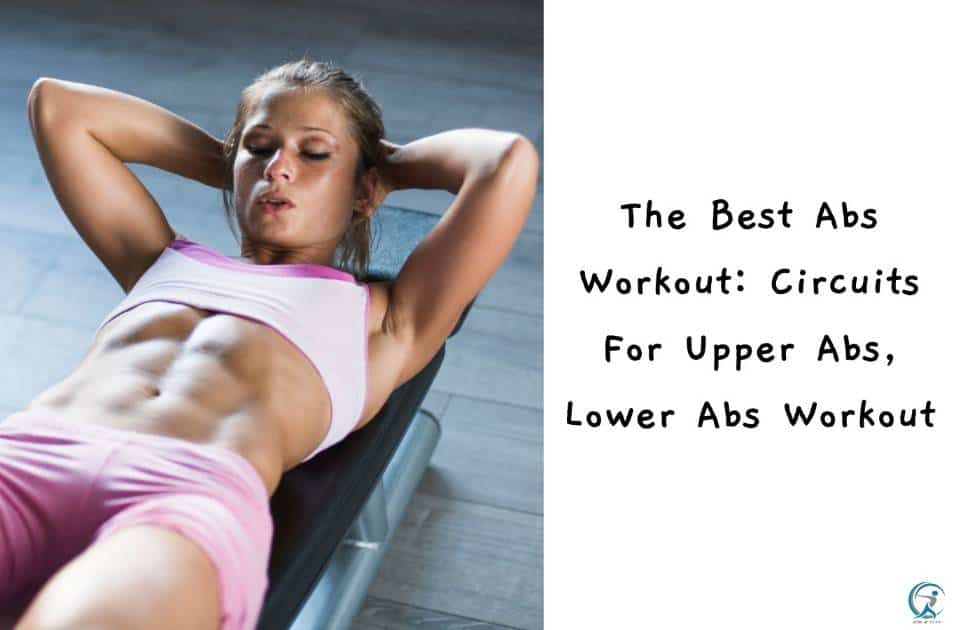Most “10-minute ab workouts” are just fatigue theater: fast reps, zero progression, and a sore neck. Then people blame their genetics. This is different.
You’re getting a 10-minute core plan built around what makes abs look and perform better: tension, control, progression, and consistency—without pretending you can spot-reduce belly fat.

BLUF / Quick Verdict
- Do this if: You want a simple, repeatable 10-minute routine that trains your abs + deep core (not just crunch volume).
- Skip this if: You have sharp pain with core work, or you insist on “lower abs only” spot-reduction as the strategy.
- The only 2 reasons that matter: It’s time-capped (you’ll do it) + it has built-in progression (you’ll improve).
SERP Gap Kill List (what this page adds that most top results don’t)
- Clear “decision filter” so you don’t pick the wrong ab style for your body/back.
- Bracing + breathing cues (so your hip flexors don’t hijack the workout).
- Progression rules (what to increase, when, and why).
- Regression rules (what to swap when your low back arches or shoulders ache).
- Anti-extension + anti-rotation emphasis (not just flexion crunches).
- 3 versions: no equipment, one-dumbbell/band, and gym-cable.
- A weekly plan (3–5 days/week) that avoids “random daily follow-along chaos.”
- A tracking scorecard so you can prove you’re getting stronger.
- Technique “stop signs” (exactly when to end a set).
- Common mistake fixes (the stuff that usually ruins core training).
Decision Filter (answer these before you start)
- Do you want abs for looks, performance, or both?
- Does twisting/rotation bother your lower back?
- Can you keep your ribs down and low back neutral during planks?
- Do you have any equipment (a light dumbbell or resistance band)?
- Will you commit to 4 weeks before swapping programs?
Specs That Matter (Translated)
Many popular 10-minute ab sessions use timed intervals (work/rest blocks) to keep the workout dense and simple.
| Spec | What it means | Who cares | Dealbreaker threshold |
|---|---|---|---|
| Work : Rest | How hard it is to keep form under fatigue | Everyone (especially beginners) | If form breaks before 20 seconds, reduce difficulty |
| Movement mix | Anti-extension + anti-rotation + flexion balance | Back-sensitive trainees, runners, lifters | Only crunching = incomplete core training |
| Tempo | Slow control vs. momentum reps | People who “feel abs” in hip flexors | If you can’t pause for 1 second cleanly, you’re rushing |
| Progression | How you make it harder week to week | Anyone who wants visible improvement | No tracking = no progression = no proof |
Real-World Use Cases (Buy/Skip logic)
-
- Runner: Needs posture + pelvic control under fatigue. Buy because stability-focused core sessions are commonly used in runner core routines.
- Desk worker: Wants a daily “spine insurance” habit. Buy because the routine prioritizes bracing and anti-extension over endless sit-ups.
- Beginner: Low back arches on leg lowers. Buy only if you use the regressions (bent knees, shorter range).
- Lifter: Wants abs that brace under load. Buy and use the loaded option 2–3 days/week (simple progressive overload).
- Back-sensitive: Rotation hurts. Buy but choose the anti-rotation version and skip twisting moves.
- Busy parent: Needs the minimum effective dose. Buy because it’s capped at 10 minutes, not a 45-minute “core day.”
The Ultimate 2026 10-Minute Abs Workout (3 Versions)
Non-negotiable form rule
If your low back arches hard, your ribs flare, or your neck starts doing the work—stop the set, regress the move, and keep training. That’s how you progress without getting wrecked.
Quick warm-up (60 seconds)
- 20 seconds: Cat-cow (slow spine motion).
- 20 seconds: Glute squeeze + ribs down (practice brace).
- 20 seconds: Deep nasal inhale + long exhale (don’t hold your breath).
Version A (No equipment, 10 minutes)
Timer: 40 seconds work / 20 seconds rest x 10 rounds. Timed circuits like this are a common structure in top “10-minute ab workout” results.
- Forearm plank (hardstyle)
Brace like someone is about to punch you; squeeze glutes; “ribs down.” - Dead bug
Move slow; keep low back heavy on the floor; exhale as the leg extends. - Side plank (left)
Hips stacked; don’t rotate open; push the floor away. - Side plank (right)
- Reverse crunch (controlled)
Posterior pelvic tilt; no swinging; stop when you lose control. - Bear plank shoulder taps
Knees hover; minimal hip sway; slower is harder. - Hollow hold (or tuck hollow)
Only if low back stays flat; otherwise tuck the knees. - Mountain climber (slow)
Drive knee under control; don’t bounce. - Bird dog
Long reaches; hips level; pause 1 second each rep. - Plank walkouts (short range)
Walk hands out until you’re challenged; walk back before you collapse.
Version B (One dumbbell or band, 10 minutes)
Why it exists: Once bodyweight is easy, load is a clean progression lever (and weighted ab work is often used for that purpose).
- RKC plank (same as above)
- Dead bug (band pulldown if available)
- Side plank (left) + top-leg raise (optional)
- Side plank (right) + top-leg raise (optional)
- Dumbbell crush press (lying)
Squeeze DB between palms over chest; brace abs as you press. - Suitcase march (one DB)
Stand tall; don’t lean; slow marching steps. - Seated knee tuck (slow)
- Pallof press hold (band)
Press out; don’t rotate; breathe. - Reverse crunch
- Plank shoulder taps
Version C (Gym cable, 10 minutes)
- Cable Pallof press hold
- Cable dead bug pulldown
- Kneeling cable crunch (light, slow)
- Hanging knee raise (or captain’s chair)
- Side plank (left)
- Side plank (right)
- Ab wheel (only if no low-back arch)
- Back extension ISO hold (short, neutral)
- Farmer carry (both hands)
- Plank
What It Nails (Pros)
- Builds “core control” (brace + breathe + resist movement) instead of only chasing the burn.
- Progression is built-in: time, rest, leverage, and load can all scale.
- Back-friendly by default if you follow the regression rules.
Where It Breaks (Cons)
- If you go fast, your hip flexors dominate and your lower back takes the hit.
- If you never progress anything, you’ll maintain—not build.
- If your nutrition is chaotic, you may build abs without seeing them clearly (definition isn’t produced by crunch volume alone).
Setup That Prevents Regret (the boring stuff that keeps you consistent)
Android checklist
- Use an interval timer set to 40/20 x 10 rounds so you don’t negotiate with the clock.
- Allow notifications so the timer cues actually hit.
- Allow Bluetooth if you use earbuds/speaker.
- Allow background activity so the timer doesn’t pause when your screen sleeps.
- If needed, disable battery optimization for the timer app (common reason timers fail).
iPhone checklist
- Use a repeating daily calendar block (10 minutes) so it becomes automatic.
- Enable notifications for the timer/app.
- Allow Bluetooth if using earbuds/speaker.
- Enable background refresh so intervals don’t fail mid-round.
- Use Focus mode to block distractions except the timer.
Progression Plan (4 weeks, zero guessing)
- Week 1: Pick Version A. Keep every rep clean. Stop sets early if form breaks.
- Week 2: Same moves, add 5 seconds to each work block (45/15 x 10).
- Week 3: Keep 40/20 but upgrade 2 moves (harder variation or small load).
- Week 4: Choose Version B or C for 2 sessions/week, Version A for 1–2 sessions/week.
Tracking Scorecard (copy/paste into Notes)
10-Min Core Log
- Date:
- Version (A/B/C):
- Timer (e.g., 40/20):
- Hardest move today:
- Form breaks happened where?
- Next progression (time/rest/variation/load):
Alternatives (Don’t be dumb with your time)
Important limitation: The GearUpToFit post sitemap could not be fetched in this environment, so exact post-URL internal links cannot be selected programmatically from the sitemap here. Use the sitemap link below to pull 5 relevant post URLs (core/abs/workout/running strength) and replace these placeholders before publishing.
- Want more training guides beyond this routine? Start at GearUpToFit fitness and training articles.
- Want the newest posts from this site’s publisher? Browse Alexios Papaioannou’s latest GearUpToFit articles.
- Buying gear to support training (watches/shoes/etc.)? Use GearUpToFit gear reviews and deep dives.
- Need to pick exactly 5 post URLs the right way? Open GearUpToFit post sitemap (URL list).
- Want a fast browse path while you update links? Use latest GearUpToFit review posts.
FAQ
Can a 10-minute ab workout get you a six-pack?
It can strengthen and grow your abs, but visible definition also depends on overall body composition and nutrition habits. No honest plan can guarantee a “six-pack” from ab work alone.
How many days per week should I do this?
Start with 3 days/week. If your form stays clean and you recover fine, move to 4–5 days/week.
Is it better to do abs before or after lifting?
If core fatigue ruins your big lifts, do core after. If core control is the priority (brace quality), do it before as a primer.
What if my lower back hurts during hollow holds or leg raises?
Regress immediately: tuck knees, shorten range, or swap to dead bugs and planks. Pain isn’t a “work harder” signal.
Do I need weights for abs?
No. But adding light load is a common way to progress once bodyweight work becomes easy.
What’s the biggest ab-training mistake?
Speed reps. Momentum makes you tired, not stronger.
Why include planks and side planks instead of only crunches?
Because the core’s job is often to resist movement and transfer force, not only to flex the spine for reps.
What’s a good “stop sign” during a set?
When ribs flare up, low back arches hard, hips sag, or neck takes over—end the set and regress.
References
- Tom’s Guide: examples of timed 10-minute ab workout structures
- Eat This, Not That!: weighted ab workout ideas for progression
- Runner’s World: 10-minute core workout ideas for runners
- University of Sydney: explanation of why spot reduction doesn’t work the way people think
- Healthline: lower-ab exercise examples and variations
Alexios Papaioannou
Mission: To strip away marketing hype through engineering-grade stress testing. Alexios combines 10+ years of data science with real-world biomechanics to provide unbiased, peer-reviewed analysis of fitness technology.
